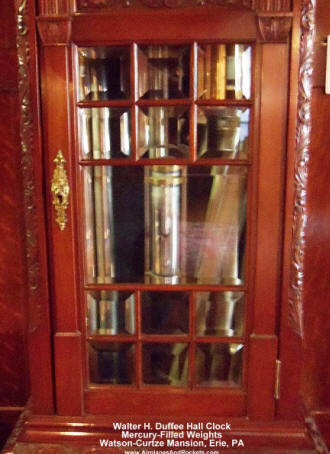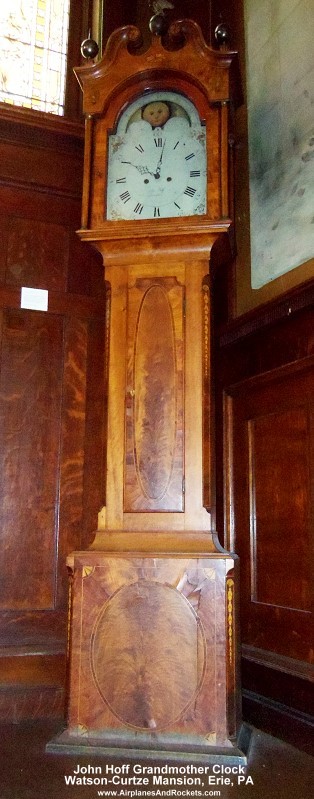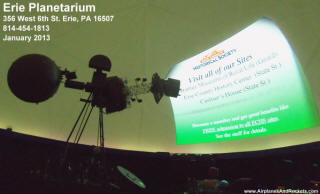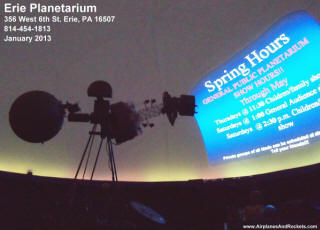|
Melanie and I toured the
Watson-Curtze
Mansion here in Erie, Pennsylvania, today. It was built in the late 1800s by businessman Harrison F. Watson,
president of H.F. Watson Paper Company. Its 22,000 square feet of floor area occupies a full basement, three full
floors, and a balcony area for orchestras above the third-floor ballroom. The level of detail in the woodwork is
incredible, with an extensive mix of hand carvings on railings and cornices and machine carvings on moldings and
trim. Each room has a unique theme woven throughout its features. Any woodworker would be envious of the craftsmanship
exhibited in the handiwork.


My current clock project is a Lorraine Grandmother Clock, built from scratch using plans purchased from Klockit. |
Of particular interest to me were the two clocks. One was a grandmother style clock built by the John Hoff company.
It sits on the first landing of the stairs. The other is a
Walter
H. Durfee Hall Clock (it appears to be pattern number 13), which was considered the clock to have for those
in the upper echelon of society at the turn of the 20th century. Having resided in the same home its entire life,
the case wood and finish appears to be in near perfect condition. Unfortunately, the clock was not operational and
its
patented tubular chimes (by Allen Harrington) that made Durfee famous were off their hooks and leaning against
the inside of the case. Incredibly, the single glass tube pendulum still contained its mercury ballast! Mercury
(Hg), atomic number 80 in the periodic table of elements, is slightly less dense than lead (Pb), which is atomic
number 82.
Why use it, then? I originally surmised that the mystique of mercury's shine and liquidity at room temperature
might be the rationale, but there is actually a practical reason for it - temperature compensation (thanks to Mr.
Rick A., of Erie, PA, for informing me of that). The pendulum rod gets longer as the ambient temperature rises and
shorter as it cools. Doing so causes the center of mass of the pendulum to shift accordingly. A longer pendulum
has a longer period of swing, which tends to slow the clock, and vice versa for a shorter pendulum. To compensate
for a center of mass change, the mercury is contained in a vial (bob) that allows a vertical Volume change. Just
as the Hg in a thermometer increases in Volume with rising temperature to move up the scale, it grows upward in
the pendulum bob, thereby shifting the center of mass back toward the clock's calibrated location. The engineering
is in knowing the thermal expansion coefficients of all the pendulum components and designing a vial shape that
precisely allows the mercury to alter its center of mass.
Mercury, however is now known to be highly toxic and easily absorbed into bloodstream through the skin. As such,
I am surprised a HAZMAT team has not yet descended upon the mansion and confiscated the overly-feared substance
from within the vials, declared it an EPA Superfund cleanup site and wiped and vacuumed the house clean, cordoned
off the entire city block until verification is made that no further contamination exists, sued the Erie County
Historical Society for harboring it, imposed weighty (get it - weighty, like Hg) and crippling fines, sued the Durfee,
Watson and Curtze families, and finally condemned the building and locked out the public for at least two centuries.
Do you think I exaggerate? Worse has been done.

John Hoff Grandmother Clock

Walter H. Durfee Hall Clock (Neither clock
is operational but both display approximately the same time, although the phases of the moons differ)
According to information available on the Internet, Durfee's clocks were specified and assembled by his company,
but the individual components were farmed out to other companies.
The original carriage house for the Watson-Curtze Mansion has been repurposed as a planetarium. The
Erie Planetarium runs shows twice
a week, and resides at 356 West 6th Street, Erie, Pennsylvania. Please call them at 814-454-1813 for show times
and descriptions.


Erie Planetarium, Erie County Historical Society
Posted January 26, 2013
|